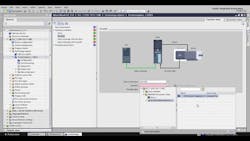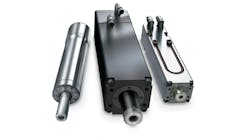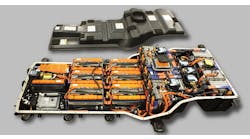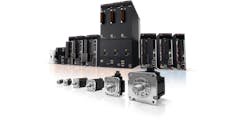In this highly connected world we live in, it seems that flying cars would have made their appearance more than a decade ago. Flying cars don’t exist yet, but more capable PLC and motion drive systems do.
Our customer, a major aerospace structural panel machine OEM, saw an opportunity to improve its mechanical footprint and overall performance. The concept involved reducing the number of servo axes and connected hardware by reimplementing a proven machine process with the latest hardware and software offering (Figure 1).
Figure 1: The concept involved reducing the number of servo axes and connected hardware by reimplementing a proven machine process with the latest hardware and software offering.
Improved product output and overall machine efficiency is not the only result; higher connectivity of drive and controller platforms also increases operator awareness and fault feedback. Long-term ownership costs thus decrease with future downtime arising from misinformed operator involvement. For the OEM or integrator support teams, connectivity to a more intelligent control package often minimizes time-sensitive on-site technician visits.
Upfront development costs eventually reduce through the reduction of custom code. Developer code should only be implemented for the specific machine-control sequence. The availability of pre-written motion control functions, referred to as blocks or instructions, encompasses a localized platform over a traditional system where data was manipulated in multiple device locations for what now can be accomplished in one software platform. New PLC and drive integrated environments are now easier to navigate. Graphical step-by-step configurators help the developer to input required system and mechanical data to quickly establish a motion control package.
None of that has anything to do with flying cars, and that's OK. In a highly competitive industry where complicated procedures need to be simplified, motion-control hardware suppliers have brought us one step closer to simplifying everything else around us.
Where does that make sense? It makes sense for quicker-to-market systems via machine builders or retrofit automation projects that have the proverbial clock associated.
DSI Innovations, a technical services company in Kernersville, North Carolina, is known for being a more technical integrator for complex motion applications while focusing on solving actual problems and not overcoming automation hardware product limitations. Especially when engineering and maintenance staffs have become less available, the ability for the user to wear multiple hats has become more apparent.
Machine builders and integrators traditionally have been industry-focused in a motion-, process- or data-system application. The risk associated with each discipline yielded industry experts, traditionally without regard to a limited development workforce. Through proper project management, developers should be proficient in all disciplines. Of course, the proper execution and use of provided tools is always the determining factor on project success rate. Specifically, with motion-control applications, the three key indicators below are first steps to ensure project success.
1. Application understanding: Motion is all about moving a load or mass. Solving the dynamic solution with motion is much like any other problematic scenario. Map it out.
Often, I draw the motion profile in a coordinate plot where key known/unknown parameters can be identified. Speed over time is the most basic element.
Most major manufacturers offer free software application tools for sizing load characteristics vs. the mechanical system. If parameters are entered to the extent the application can be understood, the suggested hardware will be derived automatically. Most distribution and manufacture sales networks have specialists to assist in sizing components as a pre-sale service.
2. Clear control scheme: Clear expectations are extremely important before implementation of hardware and software. A few examples often reveal themselves later in project, one being a means of stopping the mechanical system, which relies on electrical intervention. Many times, motion problems are solved by adding assisted electric braking means.
Another is the operator control intervention. Recently DSI was consulted on solving an implemented motion system that mechanically operated properly, but machine setup for products was not possible. In this case, the customer would have benefited from a CNC solution due to CAD designs integral to motion over a pre-set repetitive motion control scenario.
3. Delivery: This includes the initial setup and testing, and it is probably the most underestimated labor portion of a motion project. Input/output, communications and initial cycling must be completed before any code is to be tested, just like with process automation systems. Eagerness to see movement usually results in mechanical damage. All over-travel, homing, interlocks and rotations must be validated before turning any system, including but not limited to tuning procedures. The use of automatic tuning and controller settings are great, but be prepared for erratic rotation in an unknown direction.
As motion-integrated features continue to become more standard in most major automation controller hardware platforms, the cost and timeliness to implement object-handling systems have decreased. Such easy-to-find tools include quick access to configuration of the application, tuning scopes and integrated controller tags, which complement each piece of the motion technology element.
Specific industries such as logistics management directly affect the growth percentages of motion control systems that are on the rise. Projections in material handling show as much as 30% over traditional robotics, enterprise resource planning (ERP) and automatically guided vehicle (AGV) equipment.
Additionally, DSI’s business is currently comprised of as much as 70% retrofit of existing machinery over new machine build. A rise in retrofit of older systems shows long-term investments in operations over capacity expansion. The value of motion-system retrofit is easily identified through energy, productivity and serviceability.
ALSO READ: Manufacturing quality starts with the motor
Bobby Cole, automation engineer at DSI Innovations in Kernersville, North Carolina, will present "When position counts! Bringing the system into integrated control with the CPU" at 2 pm on June 27 at Siemens Automation Summit at the JW Marriott Marco Beach Resort in Marco Island, Florida.

Leaders relevant to this article:





